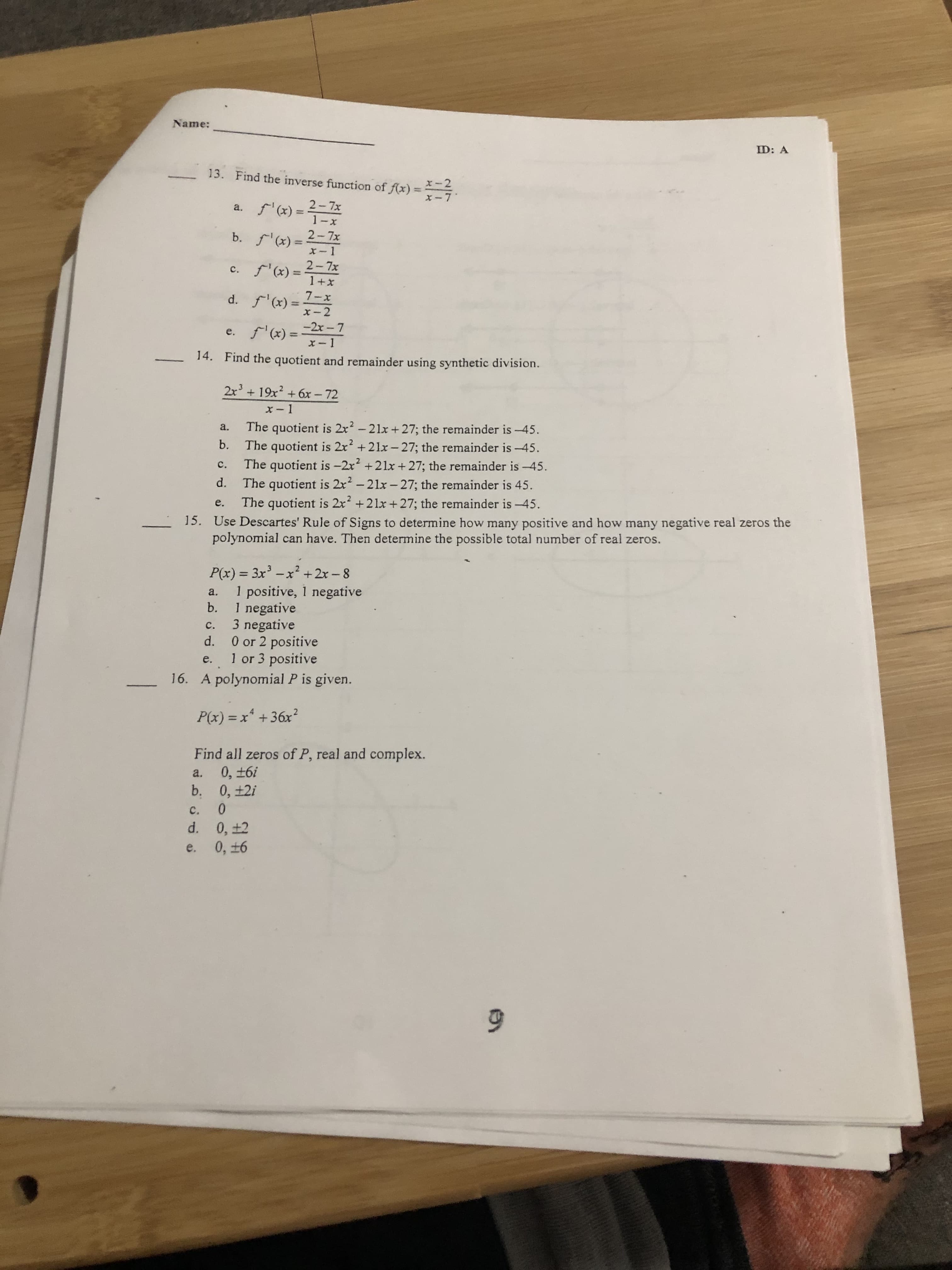Name: ID: A 13. Find the inverse function of f(x) 2-7x a. f'(x) = 2-7x b. f'(x) = c. f'(x) = 2-7x 7-x d. f'(x) = %3D e. f'(x) =-2x – 7 X-1 %3D 14. Find the quotient and remainder using synthetic division. 2x + 19x? + 6x – 72 The quotient is 2x? - 21x +27; the remainder is -45. a. b. The quotient is 2x? +21x-27; the remainder is -45. The quotient is -2x +21x + 27; the remainder is -45. The quotient is 2x2-21x- 27; the remainder is 45. The quotient is 2x +21x+27; the remainder is -45. c. d. e. -15. Use Descartes' Rule of Signs to determine how many positive and how many negative real zeros the polynomial can have. Then determine the possible total number of real zeros. P(x) = 3x -x² +2x -8 1 positive, 1 negative b. a. 1 negative 3 negative d. c. 0 or 2 positive 1 or 3 positive e. 16. A polynomial P is given. P(x) = x +36x? %3D Find all zeros of P, real and complex. 0, ±6i b. 0, ±2i 0. a. C. 0, ±2 0, ±6 d. e.
Name: ID: A 13. Find the inverse function of f(x) 2-7x a. f'(x) = 2-7x b. f'(x) = c. f'(x) = 2-7x 7-x d. f'(x) = %3D e. f'(x) =-2x – 7 X-1 %3D 14. Find the quotient and remainder using synthetic division. 2x + 19x? + 6x – 72 The quotient is 2x? - 21x +27; the remainder is -45. a. b. The quotient is 2x? +21x-27; the remainder is -45. The quotient is -2x +21x + 27; the remainder is -45. The quotient is 2x2-21x- 27; the remainder is 45. The quotient is 2x +21x+27; the remainder is -45. c. d. e. -15. Use Descartes' Rule of Signs to determine how many positive and how many negative real zeros the polynomial can have. Then determine the possible total number of real zeros. P(x) = 3x -x² +2x -8 1 positive, 1 negative b. a. 1 negative 3 negative d. c. 0 or 2 positive 1 or 3 positive e. 16. A polynomial P is given. P(x) = x +36x? %3D Find all zeros of P, real and complex. 0, ±6i b. 0, ±2i 0. a. C. 0, ±2 0, ±6 d. e.
Chapter3: Functions
Section3.5: Transformation Of Functions
Problem 4SE: When examining the formula of a function that is the result of multiple transformations, how can you...
Related questions
Topic Video
Question
Question 14 please

Transcribed Image Text:Name:
ID: A
13. Find the inverse function of f(x)
2-7x
a. f'(x) =
2-7x
b. f'(x) =
c. f'(x) =
2-7x
7-x
d. f'(x) =
%3D
e. f'(x) =-2x – 7
X-1
%3D
14. Find the quotient and remainder using synthetic division.
2x + 19x? + 6x – 72
The quotient is 2x? - 21x +27; the remainder is -45.
a.
b.
The quotient is 2x? +21x-27; the remainder is -45.
The quotient is -2x +21x + 27; the remainder is -45.
The quotient is 2x2-21x- 27; the remainder is 45.
The quotient is 2x +21x+27; the remainder is -45.
c.
d.
e.
-15. Use Descartes' Rule of Signs to determine how many positive and how many negative real zeros the
polynomial can have. Then determine the possible total number of real zeros.
P(x) = 3x -x² +2x -8
1 positive, 1 negative
b.
a.
1 negative
3 negative
d.
c.
0 or 2 positive
1 or 3 positive
e.
16. A polynomial P is given.
P(x) = x +36x?
%3D
Find all zeros of P, real and complex.
0, ±6i
b. 0, ±2i
0.
a.
C.
0, ±2
0, ±6
d.
e.
Expert Solution
This question has been solved!
Explore an expertly crafted, step-by-step solution for a thorough understanding of key concepts.
This is a popular solution!
Trending now
This is a popular solution!
Step by step
Solved in 2 steps with 2 images

Knowledge Booster
Learn more about
Need a deep-dive on the concept behind this application? Look no further. Learn more about this topic, calculus and related others by exploring similar questions and additional content below.Recommended textbooks for you


Algebra & Trigonometry with Analytic Geometry
Algebra
ISBN:
9781133382119
Author:
Swokowski
Publisher:
Cengage


Algebra & Trigonometry with Analytic Geometry
Algebra
ISBN:
9781133382119
Author:
Swokowski
Publisher:
Cengage